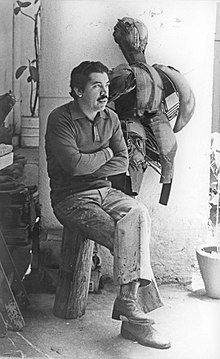Guillermo Ceniceros
While he has experimented with abstract expression, his easel work mostly classifies as figurativism and is influenced by the geometrical construct of Mexican muralism.
Ceniceros has been reviewed by notable critics such as Berta Taracena, Raquel Tibol, Alaide Foppa, Graciela Kartofel, José Angel Leyva and Eduardo Blackaller among others.
There are several publications about his work including a vast review of his art life endeavors developed by the Ministries of Culture of Durango and Nuevo León.
Ceniceros was born in a small village called El Salto, located in the municipality of Pueblo Nuevo in the Mexican state of Durango.
His father's shop would become an influence in Ceniceros' life long interest in developing his own innovative working tools.
[2][3] While at FAMA he met painters Gerardo Cantú and Ignacio Ortiz, and collaborated with them on sketches for publications of Alfonso Reyes, Pedro Garfias and other notable writers.
By then Ceniceros was already a break thru artist having had several individual exhibitions including the prestigious Palacio De Bellas Artes as well as other recognitions.
Thru the 70's and 80s Ceniceros continued his work with an emphasis on exhibits and exchanges abroad and traveling to Eastern Europe, Cuba, China, Chile, Ecuador, Italy and the United States.
His Mexico City contemporaries and circle would include names that today have become reference such as Sebastian, José Luis Cuevas, Gilberto Aceves Navarro, Benjamin Dominguez, Gustavo Arias Murueta, Byron Galvez, Leonel Maciel among others.
This led to work two years later with Luis Covarrubias to paint ethnographic murals at the Museo Nacional de Antropología.
During this project he was able to meet Rufino Tamayo, José Chávez Morado, Jorge González Camarena and Raúl Anguiano .
[1][3][4] His recognitions include two awards, the National Painting Prize from the Secretaría de Educación Pública in 1969 and the keys to the city of Durango as a distinguished visitor in 2008.
[4][9] In 1998, the state of Durango accepted a donation of paintings from the artist and sponsored the establishment of the Museo de Arte Moderno Guillermo Ceniceros in the capital.
[11] In 2009, for his seventieth birthday, the states of Durango and Nuevo León sponsored the production of his biography, called Guillermo Ceniceros: setenta años, published by La Cabra Ediciones.
[3] These depictions are what gave his work the most notice, with critics such as Raquel Tibol particularly impressed with his female nudes, which are generally have an introspective quality but not sad or melancholy.




